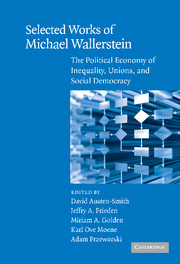 Selected Works of Michael Wallerstein
Selected Works of Michael Wallerstein Book contents
- Frontmatter
- Contents
- Preface and Acknowledgments
- 1 GENERAL INTRODUCTION
- Part I Class Conflict, the State, and Economic Limits to Democracy
- Part II The Politics of Labor Organizations
- 6 INTRODUCTION
- 7 UNION ORGANIZATION IN ADVANCED INDUSTRIAL DEMOCRACIES
- 8 CENTRALIZED BARGAINING AND WAGE RESTRAINT
- 9 POSTWAR TRADE-UNION ORGANIZATION AND INDUSTRIAL RELATIONS IN TWELVE COUNTRIES
- 10 UNIONS IN DECLINE? WHAT HAS CHANGED AND WHY
- Part III Inequality and Redistribution
- Part IV Labor and the Nordic Model of Social Democracy
- Other Books in the Series
- References
6 - INTRODUCTION
Published online by Cambridge University Press: 27 January 2010
- Frontmatter
- Contents
- Preface and Acknowledgments
- 1 GENERAL INTRODUCTION
- Part I Class Conflict, the State, and Economic Limits to Democracy
- Part II The Politics of Labor Organizations
- 6 INTRODUCTION
- 7 UNION ORGANIZATION IN ADVANCED INDUSTRIAL DEMOCRACIES
- 8 CENTRALIZED BARGAINING AND WAGE RESTRAINT
- 9 POSTWAR TRADE-UNION ORGANIZATION AND INDUSTRIAL RELATIONS IN TWELVE COUNTRIES
- 10 UNIONS IN DECLINE? WHAT HAS CHANGED AND WHY
- Part III Inequality and Redistribution
- Part IV Labor and the Nordic Model of Social Democracy
- Other Books in the Series
- References
Summary
Empirical work on trade unions and organized labor in advanced nations underwent a resurgence beginning in the 1970s. The initial impetus was twofold: first, the strike wave that in the closing years of the 1960s swept across the European countries – most markedly France and Italy, but elsewhere as well (Crouch and Pizzorno 1978) – and second, the growing recognition in the years following the first oil shock in the winter of 1973 that wage militancy was a potentially important factor affecting inflation, unemployment, and ultimately economic growth (Bruno and Sachs 1985; Olson 1982). These two sets of events sparked new interest in problems of comparative trade unions, industrial relations, and wage militancy, problems that had lain largely outside the purview of political science in the preceding decades. Unions were now seen as political organizations, both in the sense that their internal organization exhibited political features and in the sense that their activities carried with them consequences of significance for the political realm.
This part includes four of Michael Wallerstein's most important contributions to the study of trade unions in advanced industrial economies. Although the papers display a range of analytic strategies, they are all concerned with understanding variations in union strength and organization, as well as the possible effects of these variations on wage outcomes. A central thread connecting all four essays concerns the centralization of collective bargaining, a core topic of Wallerstein's (1985) doctoral dissertation, to which he returned many times thereafter.
- Type
- Chapter
- Information
- Selected Works of Michael WallersteinThe Political Economy of Inequality, Unions, and Social Democracy, pp. 109 - 115Publisher: Cambridge University PressPrint publication year: 2008
